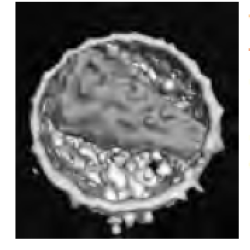Source Institutions
Source Institutions
Add to list Go to activity
Activity link broken? See if it's at the internet archive

This activity helps learners visualize the Human Immunodeficiency Virus (HIV) by constructing three-dimensional HIV particle models from paper. The model to be used is a 20-sided polyhedron (icosahedron) and represents a complete viral particle. Learners combine their finished models into one mass. This is a first step toward estimating how many HIV particles could be contained inside a white blood cell before being released into the blood stream to attack new cells.
- 10 to 30 minutes
- 1 to 2 hours
- 1 cent - $1 per student
- Ages 8 - 18
- Activity, Lesson/Lesson Plan, Model
- English
Quick Guide
Materials List (per student)
- Modeling an HIV Particle sheet printed on white card stock paper (p.5 of PDF)
- Scissors
- Cellophane tape
- Metric ruler with straight edge
- Fine point ballpoint pen with which to score cardstock before folding (felt- or gel-tipped pens are not appropriate)
- Colored markers or pencils for coloring the models (not crayons)
Subjects
-
Life Sciences
-
Cells
- Cell Structure and Function
- Cell Division
-
Diversity of Life
- Viruses and Bacteria
-
Human Body
- Health and Nutrition
- Immune System
-
Cells
-
Mathematics
-
Measurement
- Units of Measurement
- Size and Scale
- Circles
-
Measurement
Informal Categories
- Model Building
Audience
To use this activity, learners need to:
- see
- see color
- touch
Learning styles supported:
- Involves hands-on or lab activities
Other
Components that are part of this resource:
Includes alignment to state and/or national standards:
Access Rights:
- Free access
By:
- Vogt, Ed.D., Gregory L. ; Moreno, Ph.D., Nancy P.
Rights:
- All rights reserved, Baylor College of Medicine, 2011
Funding Source:
- Science Education Partnership Award from the National Center for Research Resources (NCRR) of the National Institutes of Health (NIH), 5R25 RR018605
